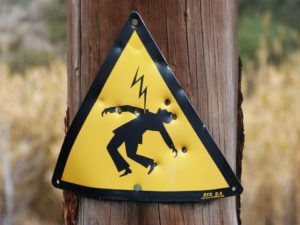Did you know that 97% of electricians have been either shocked or injured while working? Electrical contractors face constant safety hazards when on site. Electrical work is dangerous, and occupational safety is, therefore, a core need for any contractor. Here is a look at some ways to improve safety when working with electricity.
Maintain Situational Awareness
Being aware of your surroundings when on the job site is an important part of work safety. Make it a habit of locating the overhead power lines and always know where they are. When you’re moving tall equipment near any overhead power cables, ensure there are at least 10 feet between the overhead lines and the equipment. Look up and about before moving any tall object near overhead power cables.
Situational awareness also extends into other basic elements like avoiding contact with live electrical circuits. Know what’s live and what isn’t, and pay close attention to your activities if you’re near a live circuit. To be safe, it’s always smart to treat electrical circuits as if they are live.
Another thing to be aware of on a job site is condensation. Be aware of the temperature of a room, as cold rooms tend to cause condensation. Using electrical equipment in these rooms should be avoided when possible. If there’s no workaround, mount the equipment vertically.
Also, take note of all the safety signs on the job site and follow the instructions.
Know When To Be Hands Off
If a piece of equipment is not yours, or you’re not familiar with it, don’t touch it. Many people working with electrical equipment and control devices get in trouble by trying to do more than they should.
As mentioned above, a cold room is often a wet room, but it’s also important to pay attention to your own condition. If you’re working in a hot environment your own perspiration can become a hazard. If your surroundings are wet or if you’ve got wet hands or feet you should never handle electrical equipment.
If a co-worker comes into contact with a live conductor you should disconnect the power source from the circuit breaker or use something non-conductive like a leather belt to pull the plug. Your instincts may tell you to grab the person, but you should avoid touching them, the conductor or the cord.
If you must touch a piece of electrical equipment use the back of your hand. If you touch a motor to see if it’s overheating, using the back of your hand will allow you to avoid a muscle contraction that may lock your hand on to the equipment due to a shock.
Wear Appropriate Clothing
Anyone working around electricity should wear clothes that fit them without being baggy or saggy. Loose fitting clothing is a safety hazard as it puts you at risk of being entangled by any moving parts of machinery you may be using. Overly baggy pants also run the risk of tripping or stumbling, which can be extremely dangerous when working with electricity.
Beyond the fit of your clothing, it’s also wise to wear clothing that’s designed for electrical work. This includes non-conductive gloves, and shoes with insulated soles. Dress in clothes made of 100% cotton or wool as they are less likely to catch fire quickly. Blended or human-made materials like nylon, polyester, etc. catch fire very quickly and should be avoided on job sites.
Extension Cord Safety
Do not remove the grounding pin from a three-pronged cord to have it fit into a two-prong outlet. Only use certified extension cables to ensure against any fire or shock hazards. If a cord has any visible signs of damage make sure to replace it.

When undertaking any work that involves digging, first report it to the relevant authorities. The reason for this is to get the area surveyed, and all utilities within or near your job site marked. Once on site, maintain a minimum of 2 feet from the marks identifying the utility. If it becomes necessary to dig near the utility line marks only do it by hand and take extra care.
Regular Equipment Service
Perform regular maintenance on all of your equipment to ensure everything is in perfect working order. Any potential breakdown or wear that can put you at risk can be identified and remedied through inspections and service.
Protect Against Falls
If you’re working at an elevated height of more than 6 feet, you will want to make sure you have safe guards in place to protect from falling. Some of these precautions can include:
- Using personal fall arrest systems e.g. lanyards, full body harnesses, anchorage points, etc.
- Setting up of guardrails.
- Using safety net systems.
Recommended Tools and Gear
Some of the necessary gear and tools for electricians to work safely include:
Ground Fault Circuit Interrupter (GFCI)
A GFCI helps protect against any electrical shocks on the site. It monitors the flow of electricity through the circuit and instantly shuts the circuit down in case it detects a fault with the grounding. Always use a GFCI with an extension cord.
Extension Cords
When working on site only use extension cords that are of the three wire type with portable tools. Ensure they are either grounded or double insulated.
Ladders
Regular and extension ladders ought to be at least three feet taller than where they are going to land. Daily inspection of the ladders is a must to keep them in safe use.
Additional Safety Resources
At JobFLEX, our electrical estimating app is used by many contractors and we are well aware of the safety dangers they face every day. In addition to these tips, we know it’s important to stay informed on the latest safety regulations and standards. The following links also provide helpful links for contractors working with electricity:




